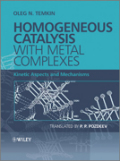
Homogeneous catalysis with metal complexes: kinetic aspects and mechanisms
Temkin, Oleg
INDICE: Notations and Abbreviations Preface to English Edition Preface Acknowledgments About the Author INTRODUCTION References CHAPTER 1 State-of-the-Art in the Theory of Kinetics of Complex Reactions 1.1. Main Concepts of the Horiuti--Temkin Theory of Steady-State Reactions 1.1.1. Reaction Mechanism: Stoichiometry and Routes 1.1.2. Kinetics: Reaction Rates with respect to Substancesand over Routes 1.1.3. Kinetic Polynomial 1.1.4. Determining the Number of Independent Parameters in a Kinetic Model. The Problem of Identifiability of Parameters 1.2. Quasi-Steady-State and Quasi-Equilibrium Approximations in Chemical Kinetics 1.2.1. Theoretical Criteria of Quasi-Steady-State Intermediate Concentrations and Quasi-Equilibrium Steps 1.2.2. Experimental Criteria of Applicability of Quasi-Steady-State Approximation in Various Systems 1.3Methods of Graph Theory in Chemical Kinetics and in Theory of Complex Reaction Mechanisms 1.3.1. Linear Mechanisms 1.3.2. Nonlinear Mechanisms 1.3.3. Other Fields of Application of Kinetic and Bipartite Graphs in Chemical Kinetics and in Theory of Complex Reaction Mechanisms 1.4. Elementary Steps. Selection Rules 1.4.1. Main Postulates, Laws, and Principles 1.4.2. Energy Selection Rules for Elementary Steps 1.4.3. Quantum-Chemical Selection Rules for Elementary Steps 1.4.4. Topological Selection Rules for Elementary Steps References CHAPTER 2 Complexity Functions of Catalysts and Reactants in Reactions Involving Metal Complexes 2.1. Mononuclear Metal Complexes 2.1.1. Complexity Functions: Variants I and II 2.1.2. Complexity Functions: Variants III and IV 2.1.3. General Problems andRecommendations 2.2. Polynuclear Complexes in Homogeneous Catalytic and Noncatalytic Reactions 2.2.1. Systems with Formation of Associates 2.2.2. Systems with Mononuclear and Polynuclear Complexes of Various Types 2.3. Catalysis withPolynuclear Copper (I) Halide Complexes in Superconcentrated Solutions 2.3.1.Copper(I) Chloride Complexes in Solution and in Crystalline State 2.3.2. Kinetics of Catalytic Reactions of Alkynes in Concentrated NH4Cl--CuCl Aqueous Solutions at Constant Complexity Functions FCu+ and FCl- 2.3.3. Determination of Compositions of Catalytically Active Copper (I) Complexes in Various Reactions2.3.4. Studying À and à Complexes of Copper (I) with Alkynes in Crystalline State and in Solution 2.3.5. Mechanisms of Acetylene Dimerization and Hydrocyanation Reactions. Crystallochemical Aspects References CHAPTER3 Multi-Route Mechanisms in Reactions Involving Metal Complexes 3.1. Factors Accounting for theAppearance and Kinetic Features of Multi-Route Mechanisms 3.2. Analysis of Multi-Route Reaction Kinetics 3.3. Conjugation Nodes and Artificial Multi-Route Character 3.4. Conjugate Processes 3.4.1. Classical Approach 3.4.2. Kinetic and Thermodynamic Conjugation in Consequent Reactions 3.4.3. Conjugation in Chain Reactions 3.4.4. Conclusions References CHAPTER4 Polyfunctional Catalytic Systems 4.1Oxidation Reactions of Organic and Ino
- ISBN: 978-0-470-66699-9
- Editorial: John Wiley & Sons
- Encuadernacion: Cartoné
- Páginas: 848
- Fecha Publicación: 16/03/2012
- Nº Volúmenes: 1
- Idioma: Inglés
